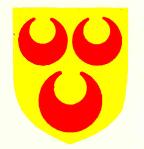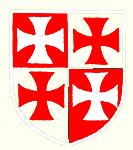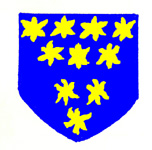The Barony of Odell

de Wahull coat of arms
The medieval Barony of Odell sprang from Walter of Flanders' manor recorded by Domesday Book of 1086. Walter held fifty and a half hides in Bedfordshire (in Odell, Astwick, Biggleswade, Henlow, Langford, Milton Ernest, Podington, Southill, Thurleigh, Totternhoe, Turvey and Wymington) as well as forty four in Northamptonshire, 6 hides, one and a half virgates in Hertfordshire and one hide, one virgate in Buckinghamshire. It was the responsibility of the Baron (the Baron de Wahull as he was known at this date) to provide the guards for the castle of Rockingham in Northamptonshire, in common with the Baron of Warden in Northamptonshire and Peterborough Abbey.
Walter the Fleming was succeeded by his son Walter and the title can be traced as follows:
- Walter the Fleming;
- Walter de Wahull, son of Walter the Fleming;
- Simon de Wahull, son of Walter - flourished around the middle of the 12th century;
- Walter de Wahull son of Simon, Baron by 1160 and until at least 1172;
- Simon de Wahull, son of Walter - died before 1197;
- John de Wahull, son of Simon - a minor until at least 1206; died about 1217;
- Rose, wife of Robert Lisle and Agnes, wife of Robert Basingham (later William Fitz Warine), sisters of John; Rose died in 1222 without issue, leaving Agnes Baroness in her own right, she died in 1238;
- John de Basingham, son of Agnes - died 1239;
- Saher de Wahull, son of Walter and brother of the Simon who died before 1197 - he died in 1250;
- Walter de Wahull, son of Saher - born 1227, died before 1269;
- John de Wahull, son of Walter - died 1296;
- Thomas de Wahull, son of John - died 1303;
- John de Wahull, son of Thomas - born 1302, died 1336;
- John de Wahull, son of John - born about 1320, died 1348;
- John de Wahull, son of John - a minor on succeeding to the title, died 1367;
- Elizabeth and Eleanor de Wahull, daughters of John - born 1364 and 1365 respectively, both died 1376;
- Nicholas de Wahull, son of the John who died in 1336 - he died in 1410;
- Thomas de Wahull, son of Nicholas - born about 1387, died in 1421;
- Thomas de Wahull, son of Thomas - died in 1441;
- John de Wahull, son of Thomas - born 1436, died in 1490;
- Fulk de Wahull, son of John - died in 1511;
- Nicholas de Wahull, son of Fulk - died in 1531;
- Anthony de Wahull, son of Nicholas - died in 1542;
- Agnes de Wahull - born seventeen days before her father's death; she married Richard Chetwood who died in 1560 and then Sir George Calvely; Agnes died in 1576;
- Richard Chetwood, son of Agnes de Wahull and Richard Chetwode - a minor on succeeding his mother, he alienated his Bedfordshire property to the Alston family in 1633 and died in 1635.

Chetwood coat of arms
At this point the barony became extinct, although Richard the last baron's great-great-grandson Knightley Chetwood claimed the title in 1739. His petition was referred to the Attorney General but nothing further came of it. His grandson Jonathan Chetwood raised the case again in 1831. The Attorney General advised referring the matter to the House of Lords' Committee for Privileges which took place in 1833. Jonathan died in 1839 without ever successfully prosecuting his claim.
This long-running saga had a further round when Constantia Elizabeth Chetwood-Aiken, great-great-granddaughter of Knightley Chetwood petitioned Queen Victoria in 1890. Again the matter was referred to the Committee for Privileges and again the claimant died, in 1892, before successfully prosecuting the claim. Her son John Chetwood Chetwood-Aiken then preferred the claim, claiming unbroken descent from Saher de Wahull but was disappointed when it was ruled that the right to a peerage depended on being called to parliament and sitting there - neither of which had happened to the de Wahulls and their successors. The medieval Barony was created to ensure military service rather than for any legislative function and so was not considered a true peerage.

Alston coat of arms